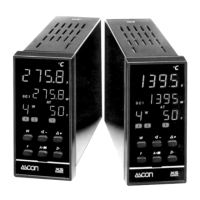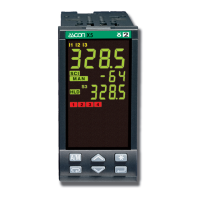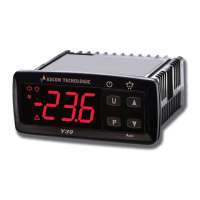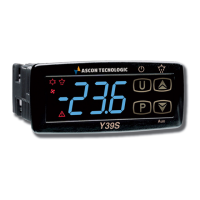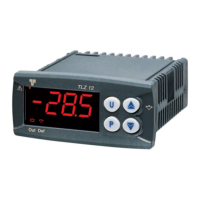Ascon Tecnologic - X34 - OPERATING INSTRUCTIONS - PAG. 10
NO contact:
at input closure the instrument
deactivates the
output configured as ot and activates the alarm and the
instrument display shows LP alternated with the variable
defined at i.dS parameter.
15 Forcing a programmed Switch-on/Switch-off (Stand-by)
event with NO contact: the input closure of at least 1 s
switches the instrument from the ON to the Stand-by state
and vice-versa, until the next event. Therefore, if switch-
on/stand-by events are programmed using the clock, this
operation mode forces the state until the next event.
16 Defrost activation command with NO contact: at input
closure the instrument starts a defrost cycle;
17 End-Defrost command with NO contact: at input closure
if the defrost cycle is in progress the instrument stops it,
otherwise inhibits the defrost start.
-1... -17 Features identical to the above but obtained through
a NC contact and a reversed logic operation.
Note: Where multiple digital inputs are configured for the
same function, the instrument will treat the contacts
as if they were parallel (and consequently regard the
result as an OR function).
5.5 Outputs and buzzer configuration
All parameters concerning the outputs configuration are
contained in the ]Ou group.
The instrument outputs can be configured using parameters
o.o1, o.o2, o.o3, o.o4.
The outputs can be configured for the following functions:
ot Controls the compressor or however, the temperature
control device;
dF Controls the defrost device (1);
Fn Controls the evaporator fans;
Au Controls the auxiliary device;
At Controls a silenceable alarm device through a contact
that is normally open and then closed when in alarm;
AL
Controls an alarm that cannot be silenced through a
contact that is normally open and closed when in alarm;
An
Controls an alarm with a memory function through a
contact that is normally open and closed when in alarm.
-t Control a silenceable alarm device through a contact
that is normally closed and then open when in alarm;
-L
Control an alarm that cannot be silenced through a
contact that is normally closed and open when in alarm;
-n
Control an alarm with a memory function through a
contact that is normally closed and open when in alarm;
on
Output ON when the instrument is in ON state. This
mode can be used to control the shop lights, anti-fog
resistances
or other utilities;
HE Controls a heating device in neutral zone control
mode (r.HC = nr);
2d Controls the second defrost device;
L1 Shop light output managed by Normal/Eco mode.
This type of output is ON in Normal mode and OFF in
Eco mode operation.
L2
Internal Light output managed by digital input. This out-
put will be ON when door is open (only if i.oF= 1, 2, 3);
oF Output disabled.
The function carried out for auxiliary output (o.oo = Au) is
defined by the parameter o.Fo and the function is conditioned
by the time set at parameter o.tu.
The parameter o.Fo can be configured for:
oF Auxiliary output not active;
1 Control output with delayed activation: the auxiliary output
is activated after o.tu delay time from ot output activa-
tion; the auxiliary output is then turned OFF when ot is
disabled. This working mode can be used as a command
for a second compressor or other utilities with the same
ot output conditions, but which must be delayed after the
compressor start up to avoid excessive current absorption;
2 Output activated by front key, digital input or Real Time
Clock: the output is activated by pressing the a key or
/AUX when suitably configured (t.UF or t.Fb = 1) or by a
digital input command if configured (i.oF= 9) or by a RTC
event. The commands by key or digital input have a bi-sta-
ble (toggle) function. Bi-stable means that the 1
st
command
turns ON the output, while the 2
nd
turns the output OFF.
In this mode, the AUX output can be turned OFF auto-
matically after the time set at o.tu parameter. When o.tu
= oF the output is activated and deactivated only manu-
ally using a key ( or
/AUX), Digital Input or RTC
ON/OFF event, otherwise, the output, once activated, is
turned OFF automatically after the o.tu time. This func-
tion can be used to manage, for example, the cell light,
anti-fog resistances or other utilities. If AUX output ON/
OFF events are programmed by Real Time Clock, the ac-
tion of the keys or digital input (in this AUX output mode)
forces output status until the next event.
3
Intake solenoid valve output. The output is used to control
the Hot-Gas intake valve in centralized systems (d.dt = HG)
defrost mode. The output configured in this way is perma-
nently activated during the temperature control operation,
while it is deactivated during defrost and post-defrost to
avoid the introduction of hot gas into the intake line.
The internal buzzer (if present) can be configured with pa-
rameter o.bu for the following functions:
oF Buzzer always disable;
1 Buzzer signal active alarms only;
2 Buzzer signal key pressed only (no alarm);
3 Buzzer signal active alarms and key pressed.
5.6 Temperature control
All parameters concerning the Temperature control functions
can be found in the ]re group.
The instrument control method is of ON/OFF type and acts
on the outputs programmed as ot and HE in response to:
Pr1 probe measurement,
Set Point(s) SP (or SPE and/or SPH) value(s);
Intervention differential r.d (or r.Ed and/or r.Hd) value;
r.HC the operating mode. Via the parameter r.HC the follow-
ing functions can be obtained:
C Cooling; H Heating
Depending on the function mode programmed with param-
eter r.HC the differential is automatically considered by the
controller with positive values for a Refrigeration control
(r.HC = C) or negative values for a Heating control (r.HC = H).
SP
Temp.
r.d
time
offoff
SP
r.d
time
ON
rHC = C rHC = H
offoffON ON ON ON ON
output
ot
output
ot
Pr1
Temp.
Pr1
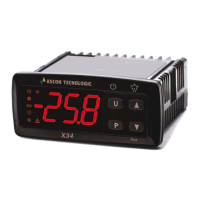
